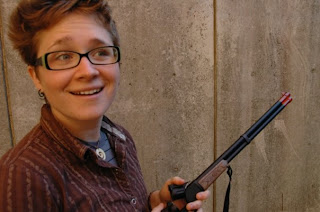Second to the shellac record and perhaps the player piano, the invention of magnetic tape is widely regarded as the pivotal addition to music in the twentieth century. Conceived in 1900 by Valdemar Poulsen, a Danish engineer who magnetized plastic tape coated with ferric particles, magnetic tape was the initial development in audio recording that served as impetus for the 33 1/3 vinyl record, the stereophonic stylus, and the cassette tape. As the 20th century felt the inevitable beckon of the 21st, digital technology again redefined both music production and distribution. Shortly after WinAmp popularized the "digital jukebox" in 1997, portable .mp3 players entered development. And thus it came into being... the iPod.
Drastically shifting the means by which people receive music, the iPod quickly became the must-have gadget--easy, convenient, portable, stylish, even relatively inexpensive. Previously, technology had only sought to improve audio fidelity and unit durability. Even the portable cassette Walkman was simply a little boombox sans speakers. However, with the iPod, people could navigate catalogs of music with the press of a button and write the soundtracks to their own lives--any where, any time. The theoretical implications of such a technology are countless; its actual application have only begun to be realized.
Who uses iPods? What classes of people? What ages? Which gender? How do people use their iPods? When? Where? For what purposes? What features of the iPod actually change the way people listen to music? Do people still buy records? They can't all download illegally, can they? Are certain genres more popular on iPods? Which ones? For what reason? How do people relate to their iPods, and to what part? The look? The convenience? The features? Or, god forbid, the music itself? It seems the most obvious questions prompt the most revealing answers.
Sampling the student population of Brown University, I attempted to find a cross-section of iPod users who answered these questions in a variety of ways in order to glimpse the broad capabilities of the iPod and its innumerable uses. While I interviewed users across the spectrum of age, race, gender and class, the eventual determining factors for their inclusion were the model of their iPod (or iPhone), their primary uses, and their opinions of the technology. Equally important to my analysis, the focus of my ethnographic research atypically centers around a technology, not a population or subculture. Because of this, many of the common responses do not reveal relationships of people together, rather individuals with their own digital music. The three interview excerpts below represent three differing personal/digital relationships, which best depict the range of iPod use. (Personal photos submitted by interviewees.)

Michael Fruta, senior.
Model: 4gb nano
"I use [my iPod] getting to and from places, walking. Other times too, but mostly just having it on in the background."
"All my music is on my computer. I get all my music from bit torrent sites so the iPod is really the only way I can keep it with me."
"Yeah, who buys CDs anymore? Not me."

Rebecca Sigel, sophomore.
Model: 20gb video
"Honestly, I rarely use it. Only when I'm driving do I use it regularly, but it's more convenient just to pick something than to change CDs in traffic."
"I still buy a few CDs, and tracks off iTunes, but other than those and maybe some NPR, most of my music is on my iPod or computer."
"Not that I don't enjoy the "Wicked" soundtrack, but sometimes I'm embarrassed of my iPod contents."

Ethan Levy, junior.
Model: iPhone
"I use my iPhone for music all the time. Biking, walking, chilling, sleeping, working, cooking. I have a set of speakers that lets me listen to it at home all the time."
"I really like [the Shuffle feature]. Most of the time I just want to listen to an artist, and I'll have a lot of their stuff, so I just use it to get to know more of what I have."
"Sharing? I do use my iPhone to show music to other people, and vice versa, but also the iPhone Internet makes it easy to access a lot as well."
Beyond these three interviews, several more students described similar patterns of usage, and even some to greater extremes. (Despite the technological literacy of most students, I specifically excluded the most tech-savvy interviewees who live and die by their gadgets with no regard for the music itself.) Athletes used iPods for working out, rather than driving; users of the iPod Shuffle embraced the feature instead of avoiding it--different profiles with different uses, and indeed none too surprising.
The variance of iPod use I found in Brown students is predictable. Some completely reliant on the technology, others indifferent to its myriad features. Yet the conclusion I have finally drawn is as revealing of the iPod itself as it is a number of new technologies. What I found in interviewing users from this age group is that the iPod is now a technology inseparable from its digital contents; iPods exist no longer as a convenient replacement for CDs and vinyl—by in large, they have relegated all analog media to antiquity, and iPod users could care less.
The cyclical patterns of fashion seem to skip generations of technology. Vinyl records have come back into fashion for the hipster scene because they are outdated enough to warrant revival; cassettes and Discmen are yet to deserve such categorization. This is not unlike the repopularized classic typewriters for those who desire subcultural supremacy by rejecting modern invention, yet surely there are few users who work on a first generation Apples because they are realistically practical. (They. are. not.) The iPod generation has established itself as perhaps the most significant landmark in this cycle to date. There is no going back. The iPod here and will not regress. More than any specific words that interviewees said about their daily iPod use, it was the tone in which all interviewees spoke--a matter-of-fact acceptance of iPod technology--that illustrated to me that however it was used, the iPod was simply an accepted facet of their life that was no longer just novelty.
Nowadays, the iPod isn't even questioned. New features, redesigns, the ever-expanding access--the iPod forces all music listeners to accept it and let go of obsolete technologies. As a traditionalist, I find this realization hard to swallow. Nevertheless, as I have learned from others time and time again, the iPod will assuredly soundtrack my generation.
Steven H. Hall
May 6, 2009
Works cited:
Chris Anderson, "The Long Tail"
Tia DeNora, "Music as a technology of the self"
Mark Levine, "Pandora Maps the Musical Genome"
Steven Levy, "The perfect thing: how the iPod shuffles commerce, culture, and coolness"
Gerald Marzorati, "How the Album Got Played Out"
Drastically shifting the means by which people receive music, the iPod quickly became the must-have gadget--easy, convenient, portable, stylish, even relatively inexpensive. Previously, technology had only sought to improve audio fidelity and unit durability. Even the portable cassette Walkman was simply a little boombox sans speakers. However, with the iPod, people could navigate catalogs of music with the press of a button and write the soundtracks to their own lives--any where, any time. The theoretical implications of such a technology are countless; its actual application have only begun to be realized.
Who uses iPods? What classes of people? What ages? Which gender? How do people use their iPods? When? Where? For what purposes? What features of the iPod actually change the way people listen to music? Do people still buy records? They can't all download illegally, can they? Are certain genres more popular on iPods? Which ones? For what reason? How do people relate to their iPods, and to what part? The look? The convenience? The features? Or, god forbid, the music itself? It seems the most obvious questions prompt the most revealing answers.
Sampling the student population of Brown University, I attempted to find a cross-section of iPod users who answered these questions in a variety of ways in order to glimpse the broad capabilities of the iPod and its innumerable uses. While I interviewed users across the spectrum of age, race, gender and class, the eventual determining factors for their inclusion were the model of their iPod (or iPhone), their primary uses, and their opinions of the technology. Equally important to my analysis, the focus of my ethnographic research atypically centers around a technology, not a population or subculture. Because of this, many of the common responses do not reveal relationships of people together, rather individuals with their own digital music. The three interview excerpts below represent three differing personal/digital relationships, which best depict the range of iPod use. (Personal photos submitted by interviewees.)

Michael Fruta, senior.
Model: 4gb nano
"I use [my iPod] getting to and from places, walking. Other times too, but mostly just having it on in the background."
"All my music is on my computer. I get all my music from bit torrent sites so the iPod is really the only way I can keep it with me."
"Yeah, who buys CDs anymore? Not me."

Rebecca Sigel, sophomore.
Model: 20gb video
"Honestly, I rarely use it. Only when I'm driving do I use it regularly, but it's more convenient just to pick something than to change CDs in traffic."
"I still buy a few CDs, and tracks off iTunes, but other than those and maybe some NPR, most of my music is on my iPod or computer."
"Not that I don't enjoy the "Wicked" soundtrack, but sometimes I'm embarrassed of my iPod contents."

Ethan Levy, junior.
Model: iPhone
"I use my iPhone for music all the time. Biking, walking, chilling, sleeping, working, cooking. I have a set of speakers that lets me listen to it at home all the time."
"I really like [the Shuffle feature]. Most of the time I just want to listen to an artist, and I'll have a lot of their stuff, so I just use it to get to know more of what I have."
"Sharing? I do use my iPhone to show music to other people, and vice versa, but also the iPhone Internet makes it easy to access a lot as well."
Beyond these three interviews, several more students described similar patterns of usage, and even some to greater extremes. (Despite the technological literacy of most students, I specifically excluded the most tech-savvy interviewees who live and die by their gadgets with no regard for the music itself.) Athletes used iPods for working out, rather than driving; users of the iPod Shuffle embraced the feature instead of avoiding it--different profiles with different uses, and indeed none too surprising.
The variance of iPod use I found in Brown students is predictable. Some completely reliant on the technology, others indifferent to its myriad features. Yet the conclusion I have finally drawn is as revealing of the iPod itself as it is a number of new technologies. What I found in interviewing users from this age group is that the iPod is now a technology inseparable from its digital contents; iPods exist no longer as a convenient replacement for CDs and vinyl—by in large, they have relegated all analog media to antiquity, and iPod users could care less.
The cyclical patterns of fashion seem to skip generations of technology. Vinyl records have come back into fashion for the hipster scene because they are outdated enough to warrant revival; cassettes and Discmen are yet to deserve such categorization. This is not unlike the repopularized classic typewriters for those who desire subcultural supremacy by rejecting modern invention, yet surely there are few users who work on a first generation Apples because they are realistically practical. (They. are. not.) The iPod generation has established itself as perhaps the most significant landmark in this cycle to date. There is no going back. The iPod here and will not regress. More than any specific words that interviewees said about their daily iPod use, it was the tone in which all interviewees spoke--a matter-of-fact acceptance of iPod technology--that illustrated to me that however it was used, the iPod was simply an accepted facet of their life that was no longer just novelty.
Nowadays, the iPod isn't even questioned. New features, redesigns, the ever-expanding access--the iPod forces all music listeners to accept it and let go of obsolete technologies. As a traditionalist, I find this realization hard to swallow. Nevertheless, as I have learned from others time and time again, the iPod will assuredly soundtrack my generation.
Steven H. Hall
May 6, 2009
Works cited:
Chris Anderson, "The Long Tail"
Tia DeNora, "Music as a technology of the self"
Mark Levine, "Pandora Maps the Musical Genome"
Steven Levy, "The perfect thing: how the iPod shuffles commerce, culture, and coolness"
Gerald Marzorati, "How the Album Got Played Out"
